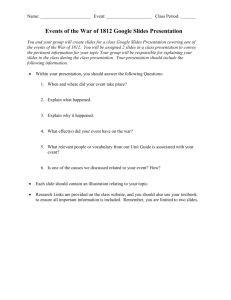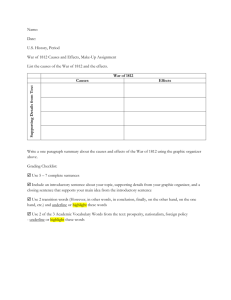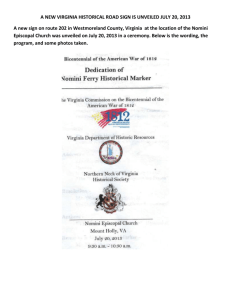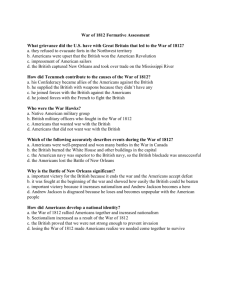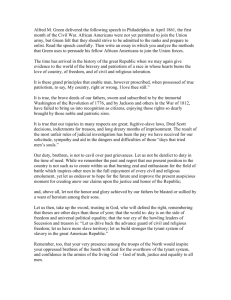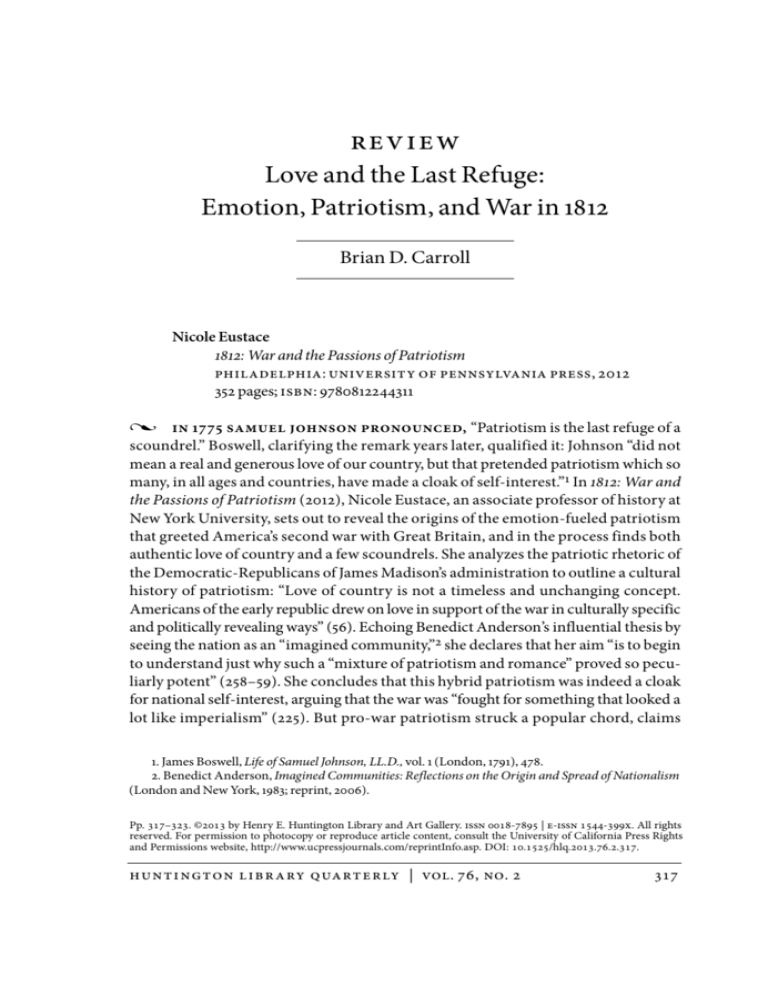
review
Love and the Last Refuge:
Emotion, Patriotism, and War in 1812
Brian D. Carroll
Nicole Eustace
1812: War and the Passions of Patriotism
philadelphia: university of pennsylvania press, 2012
352 pages; isbn: 9780812244311
in 1775 samuel johnson pronounced, “Patriotism is the last refuge of a
scoundrel.” Boswell, clarifying the remark years later, qualified it: Johnson “did not
mean a real and generous love of our country, but that pretended patriotism which so
many, in all ages and countries, have made a cloak of self-interest.”1 In 1812: War and
the Passions of Patriotism (2012), Nicole Eustace, an associate professor of history at
New York University, sets out to reveal the origins of the emotion-fueled patriotism
that greeted America’s second war with Great Britain, and in the process finds both
authentic love of country and a few scoundrels. She analyzes the patriotic rhetoric of
the Democratic-Republicans of James Madison’s administration to outline a cultural
history of patriotism: “Love of country is not a timeless and unchanging concept.
Americans of the early republic drew on love in support of the war in culturally specific
and politically revealing ways” (56). Echoing Benedict Anderson’s influential thesis by
seeing the nation as an “imagined community,”2 she declares that her aim “is to begin
to understand just why such a “mixture of patriotism and romance” proved so peculiarly potent” (258–59). She concludes that this hybrid patriotism was indeed a cloak
for national self-interest, arguing that the war was “fought for something that looked a
lot like imperialism” (225). But pro-war patriotism struck a popular chord, claims
1. James Boswell, Life of Samuel Johnson, LL.D., vol. 1 (London, 1791), 478.
2. Benedict Anderson, Imagined Communities: Reflections on the Origin and Spread of Nationalism
(London and New York, 1983; reprint, 2006).
Pp. 317–323. ©2013 by Henry E. Huntington Library and Art Gallery. issn 0018-7895 | e-issn 1544-399x. All rights
reserved. For permission to photocopy or reproduce article content, consult the University of California Press Rights
and Permissions website, http://www.ucpressjournals.com/reprintInfo.asp. DOI: 10.1525/hlq.2013.76.2.317.
huntington library quarterly | vol. 76, no. 2
317
318
brian d. carroll
Eustace, because most Americans had a vested interest in expanding U.S. territory and
increasing its population. To them reproduction and land acquisition were the essence
of freedom.
One of a host of books published to coincide with the war’s bicentennial, 1812
marks a resurgence of interest in what many have called a “forgotten war.”3 A spate of
recent books seeks to bring it to remembrance, including works on various facets of
the conflict and biographies of key figures. Further, historians who once looked to the
Revolution for America’s origins have been increasingly drawn to the early republic to
seek the genesis of national political, social, economic, and cultural trends.4 Author of
the well-received Passion is the Gale: Emotion, Power, and the Coming of the American
Revolution (2007), Eustace is a historian of emotion, a subfield of cultural history that
sees feelings as the internalization of cultural values and norms. Historians of emotion
study continuity and change in human emotion over time and analyze the language
past cultures have used to describe it.5 In 1812 in particular, Eustace is concerned with
the patriotic discourse about the war and the emotional response to that discourse,
and the role both played in creating American nationalism. Patriotism, she argues, is a
form of love, something one feels. The five chapters of 1812 comprise what is essentially
a collection of microhistories. She unpacks layers of meaning embedded in these case
studies to highlight the intersections between emotion, politics, and media on the one
hand, and ideas about citizenship, gender, race, and family on the other.
For Eustace, what began as a conflict over naval rights became a kind of cultural event that tested the “strength and meaning of American patriotism in a nation
3. A sampling of these books includes Walter R. Borneman, 1812: The War that Forged a Nation
(New York, 2005); Jon Latimer, 1812: War with America (Cambridge, Mass., 2010); George Daughan,
1812: The Navy’s War (New York, 2011); Gene Allen Smith, The Slaves’ Gamble: Choosing Sides in the
War of 1812 (Houndmills, U.K., 2013); Paul Gilje, Free Trade and Sailors’ Rights in the War of 1812 (Cambridge, 2013); Sandy Antal, A Wampum Denied: Procter’s War of 1812 (Ottawa, 2011); Donald R. Hickey,
The War of 1812: A Forgotten Conflict, Bicentennial Edition (Champaign, Ill., 2012); J. C. A. Stagg, The
War of 1812: Conflict for a Continent (Cambridge, 2012); and Hugh Howard, Mr. and Mrs. Madison’s
War: America’s First Couple and the Second War of Independence (New York, 2012). There were also
two documentary films by the History Channel (2004 and 2005), and one by PBS (2011). Biographies
include Catherine Allgor, Dolley Madison: The Problem of National Unity (Boulder, Colo., 2012);
Mary Cutts, The Queen of America: Mary Cutts’s Life of Dolley Madison, ed. Catherine Allgor (Charlottesville, Va., 2012); Kevin R. C. Gutzman, James Madison and the Making of America (New York,
2012); and Richard Brookhiser, James Madison (New York, 2011).
4. Ralph D. Gray and Michael A. Morrison pointed this out as early as 1994, writing of “renewed
interest in the early republic”; New Perspectives on the Early Republic: Essays from the Journal of the
Early Republic, ed. Gray and Morrison (Champaign, Ill., 1994), ix–x. Later treatments include Whither
the Early Republic: A Forum on the Future of the Field, ed. John L. Larson and Michael A. Morrison
(Philadelphia, 2005), and Gordon S. Wood, The Idea of America: Reflections on the Birth of the United
States (New York, 2011).
5. See William M. Reddy, The Navigation of Feeling: A Framework for the History of Emotions
(Cambridge, 2001), though it is not a comprehensive overview; Barbara H. Rosenwein, “Problems and
Methods in the History of Emotions,” Passions in Context 1, no. 1 (2010): 1–32; Rosenwein, “Worrying
about Emotions in History,” American Historical Review 107 (2002): 821–45; The Social Construction of
Emotions, ed. Rom Harré (Oxford, 1986); An Emotional History of the United States, ed. Peter N. Stearns
and Jan Lewis (New York, 1998); and Anger’s Past: The Social Uses of an Emotion in the Middle Ages,
ed. Barbara H. Rosenwein (Ithaca, N.Y., 1989).
review | emotion, patriotism, and war in 1812
319
torn by sectional and political factionalism” (xiii). In her telling, Republicans of the
era hit on a winning maxim—that strong emotions influence judgments more effectively than rational arguments or successful policies. War supporters used “the public
prints” (xvi) as well as other popular media formats to sell the conflict to readers,
attempting to rouse fear and making emotional appeals to patriotism, repeating the
“party line” until it became the dominant interpretation of the war.6 The message
the press and Republican supporters pitched, Eustace shows us, was that the war was
about procreation and family formation—love, lust, marriage, and children. War supporters exploited a wide range of media and genres, including novels, plays, captivity
narratives, speeches, sermons, broadsides, and songs, to manipulate how people felt
about and experienced the war.
In the first and perhaps strongest chapter, “Celebrating Love, Liberty, and Progeny,” Eustace argues that Americans perceived population as the basis of the nation’s
strength. The framing vignette centers on divergent British and American interpretations of Thomas Malthus’s Essay on the Principle of Population (1798). According to
Malthus, unrestrained population growth not only exhausted food supplies, causing
famine and suffering, but unchecked growth was also a moral evil that fueled territorial aggression, and, in America’s case, led to the dispossession and destruction of
Indians. Americans rejected the latter part of Malthus’s thesis, Eustace shows, substituting the pervasive “folk wisdom” that unchecked reproduction was a sign of personal
and national success and that population and power were linked. Eustace marshals
the writings of various Americans, such as Benjamin Franklin, Parson Weems, and
Thomas Jefferson, all extolling the virtues of large families and population growth.
Most notably, publisher Hezekiah Niles not only expunged Malthus’s critique of
U.S. expansionism from his 1811 American edition of Essay on the Principle of Population but also silently inserted a ringing endorsement of Manifest Destiny. The pursuit
of happiness articulated in the Declaration of Independence included, to most Americans, the inalienable right to marry and the freedom to reproduce. Eustace then characterizes free trade, sailors’ rights, and sovereignty—typically cited as causes for the
war—as mere smokescreens for larger American ambitions: British territory in Canada
and Natives in the Ohio Country and in the southeast blocked the national imperative
of westward expansion. Polemicists supported this imperative by creating a patriotism modeled on romantic love and sexual attraction, which would both motivate
national action and stand in for a lack of ethnic nationalism. Women were expected to
participate in this culture of “ardent patriotism,” but only as alluring yet virtuous vessels of desire. They were to give men something to fight for and to reward them with
sexual pleasure once they were married. Only within the confines of a matrimonial
bedchamber was this patriotic, romantic ardor legitimate, because it supported large
families that increased the nation’s strength.
6. The result is an implied “Fox News Effect,” I suggest. See Stefano DellaVigna and Ethan Kaplan,
“The Fox News Effect: Media Bias and Voting,”Quarterly Journal of Economics 122, no. 3 (2007):
1187–1234; Marvin Kitman,“The Fox News Effect,” Nation, March 26, 2012; and Jonathan S. Morris and
Peter L. Francia, “Cable News, Public Opinion, and the 2004 Party Conventions,” Political Research
Quarterly 63, no. 4 (2010): 834–49.
320
brian d. carroll
In chapter 2 Eustace builds her argument of emotion around the court-martial
of General William Hull, the American commander who surrendered Detroit in 1812.
As she recounts, pro-administration critics accused Hull of cowardice for his failure to
maintain the “emotional ardor” of his troops. Hull was clearly a scapegoat and the
court-martial a partisan show-trial designed to deflect criticism from failed Republican policies, she shows. Pitted against Hull in the proceedings was Colonel Lewis Cass.
For Eustace this confrontation represents an important cultural shift as well as generational differences in attitudes toward emotion. A member of the Revolutionary generation steeped in classical republicanism, Hull was confident that elites like himself
governed their passions, while Cass, part of the younger generation that came of age
after the Revolution, was influenced by the democratic ideals of Jeffersonian Republicans. Human nature was supposed to be subject to powerful emotions. Eustace concludes that Hull was popularly blamed for the loss of Detroit because of “the Nation’s
embrace of the emotional” (71). This account is the best articulation of her argument
on the nature of emotion, and it dovetails with what historian William M. Reddy elsewhere calls “emotional regimes” or dominant norms of emotional life.7
Chapter 3 examines propaganda about impressment. War rhetoric emphasized
that the conflict was fought to free lovelorn sailors torn from their wives and families,
rather than in support of more blatantly imperialistic U.S policy. Equating love with
liberty, Eustace argues, Americans saw selecting a spouse as an exercise in democratic
self-determination. Crafted by “politicians determined to maintain power” (79) and to
actively shape public perceptions, this rhetoric required willful blindness to the expansion of slavery and the conquest of Indian lands, which had become official U.S. policy.
Propaganda depicted impressment as clear evidence of British tyranny and injustice,
causing disruption and heartache—because it separated families.
Eustace asserts in her well-argued fourth chapter that “U.S. residents believed
that gaining control of North America would give them a celebrated place ‘in the
history of the western world,’” and that “Indian rights were ‘forfeited’ to, not violated
by, the United States, implying that Indians deserved to have their lands confiscated
in retaliation for crimes against humanity” (146). Demographics were a form of warfare against Indians and American wombs were weapons; population expansion
enabled national might and enacted divine intentions. To Americans, the clearest
proof of British opposition to liberty was the willingness to employ “savage” Indians
against American civilians during wartime. Killing Tecumseh and other Indians who
resisted American expansion thus became a way of preserving American women,
families, and communities. This rhetoric is clearest, Eustace argues, in captivity
narratives, the quintessential early American literary form. Anti-Indian rhetoric in
this genre demonized and dehumanized Indians in order to “evoke maximum
loathing” (124), promote war, and justify expansion. Indians were depicted as disrupting American civilization by hoarding land that whites could use, thus preventing them from populating the continent.
7. While Eustace never uses the term, her constructions are analogous to Reddy’s in Navigation of
Feeling, 129.
review | emotion, patriotism, and war in 1812
321
Focusing on slavery, race, and families, the last chapter shows how early opponents of slavery echoed pro-war arguments over impressment, contending that
slavery undermined marriage and families. The issue could have cost Republicans
the moral high ground, given the reasoning behind their pro-war arguments. For, if
Britain had no right to impress American citizens, what right did U.S. slaveholders
have to enslave blacks? Republican apologists made the specious argument that impressment was worse than slavery. Yet, because of America’s commitment to slavery,
Eustace shows that blacks had little reason to remain loyal to the United States. Further, the potential for rebellions made slavery a liability during wartime. But precious
few white Americans advocated freedom or equality for blacks as a solution. Again,
sex and reproduction ultimately framed American discussions: frightened white men
feared that slaves would use British successes as an opportunity to rebel and rape
white women. Throughout the war, Eustace shows, American writers delighted in
tales of British, black, and Indian sexual savagery and juxtaposed them repeatedly
with American gallantry.
In her conclusion, Eustace contends that the War of 1812 was a series of defeats
and embarrassments for the United States. But in Republican rhetoric this trend was
reversed by the miraculous last-minute victory at New Orleans in January 1815.
Americans finally had cause to rejoice, for the nation’s men had protected their
homes, wives, and sweethearts from the British, depicted in the press as villainous
rapists, she shows. Republicans, now redeemed, expanded their power and influence
and enacted their vision for America, creating an expansionist, democratic, slaveowning republic. Marshaling America’s patriotic spirit was the central achievement of
the war, Eustace concludes.
While Eustace’s narrative of American perceptions of the war deserves serious
consideration by scholars of the early republic, especially cultural historians, it fails to
take up several important cultural-historical themes. Surprising, for instance, is the
lack of any discussion of Romanticism in 1812, even though at points her terms “ardent
patriotism,” “emotional ardor,” and the “culture of ardor” seem to parallel the European cultural and intellectual movement that rejected Enlightenment rationalism,
instead privileging the heroic achievements of individuals and artists who celebrated
the primacy of feeling, bravery, and the epic nature of “national” destinies.8 Apparently
seeing no similarities between America and Europe, Eustace instead argues for American emotional exceptionalism.
More significant is her lack of a sustained investigation of the influence of ideas
about masculinity and honor on war rhetoric. While she certainly acknowledges the
importance of gender and sex to her thesis, she universalizes manhood where she
needs to historicize it. She argues that women, non-whites, and non-voting white men
were all part of an enlarged public sphere. Yet her sources are not just gendered, they
are also prescriptive, authored by elites subscribing to an idealized vision of hegemonic
8. See David Aram Kaiser, Romanticism, Aesthetics, and Nationalism (Cambridge, 2004); and
Serhiy Bilenky, Romantic Nationalism in Eastern Europe: Russian, Polish and Ukrainian Political
Imaginations (Stanford, Calif., 2012).
322
brian d. carroll
manhood, to the exclusion of all other masculinities.9 War discourse was not only a
commentary on a new emotional regime, as Eustace contends. It was also an affirmation of white, propertied manhood and a reclaiming of national honor, as historians
argued more than a decade ago—including Dana Nelson in National Manhood: Capitalist Citizenship and the Imagined Fraternity of White Men (1998) and Mark E. Kann in
The Gendering of American Politics: Founding Mothers, Founding Fathers, and Political
Patriarchy (1999), and more recently, to a lesser extent, Rosemarie Zagarri in Revolutionary Backlash: Women and Politics in the Early Republic (2007). Defending the
country was presented as a collective defense of the nation’s manhood. That Eustace
never fully discusses the part that honor played in the construction of elite male life is a
serious omission. Critics, especially Bertram Wyatt-Brown in Southern Honor: Ethics
and Behavior in the Old South (1982) and Joanne Freeman in Affairs of Honor: National
Politics in the New Republic (2001), chronicle the influence of the era’s honor culture
on politics and argue that it served as a guiding cultural precept for men, northern and
southern.10 Even Eustace’s discussion of a postwar satire entitled The Adventures of
Uncle Sam in Search after His Lost Honor (1816) sidesteps any consideration of honor.
And it was not just for elites, as Elliot Gorn showed almost thirty years ago in his seminal article on fighting in the southern backcountry.11 In the fifth chapter of 1812,
Eustace fails to bring up working-class constructions of masculinity or honor in relation to the 1813 murder of two Native Americans, Nicholas Crevay and his wife, by two
white factory workers Crevay had publicly humiliated by besting them in a wrestling
match. She reads the incident only in relation to marriage.
Eustace’s innovative interpretation invites comparison with the most significant
recent reappraisal of the war, Alan Taylor’s The Civil War of 1812: American Citizens,
British Subjects, Irish Rebels, and Indian Allies (2010). Both emphasize issues of loyalty,
citizenship, and national allegiance, and refreshingly focus on the less-studied western
theater of the war. Both also agree that, despite New Orleans, the war was a string of
military disasters for America, and that the war’s chief objective was territorial expansion. Eustace, however, argues that Americans united behind pro-war Republican
discourse, while Taylor, perhaps more convincingly, posits that America’s lack of mili9. Scholars describe competing models of masculinity, each affected by such variables as class,
ethnicity, religion, and race, and defined in relation to a culture’s dominant model of maleness or
“hegemonic” manhood. See R. W. Connell, Masculinities, 2nd ed. (Berkeley, Calif., 2005).
10. See also Wyatt-Brown, “Andrew Jackson’s Honor,” Journal of the Early Republic 17, no. 1 (1997):
1–36; and The Shaping of Southern Culture: Honor, Grace, and War, 1760s–1880s (Chapel Hill, N.C., 2001).
11. Elliot J. Gorn, “‘Gouge and Bite, Pull Hair and Scratch’: The Social Significance of Fighting in
the Southern Backcountry,” American Historical Review 90, no. 1 (1985): 18–43. For more on workingclass constructions of manhood, see Harry S. Laver, “Refuge of Manhood: Masculinity and the
Militia Experience in Kentucky,” in Southern Manhood: Perspectives on Masculinity in the Old South,
ed. Craig T. Friend and Lorri Glover (Athens, Ga., 2004), 1–21; Richard B. Stott, Jolly Fellows: Male
Milieus in Nineteenth-Century America (Baltimore, 2009); Joshua R. Greenburg, Advocating the Man:
Masculinity, Organized Labor, and the Household in New York, 1800–1840 (New York, 2008); Mary H.
Blewitt, Men, Women, and Work: Class, Gender, and Protest in the New England Shoe Industry, 1780–1910
(Champaign-Urbana, Ill., 1988); and Myra C. Glenn, “Troubled Manhood in the Early Republic:
The Life and Autobiography of Sailor Horace,” Journal of the Early Republic 26, no. 1 (2006): 59–93.
review | emotion, patriotism, and war in 1812
323
tary success showed not how united Americans were but how divided—leading him to
characterize the conflict as a virtual civil war that revealed deep fault lines in American
society. So while discourse and perception are the heart of the matter for Eustace,
telling the untold story behind the rhetoric is paramount for Taylor—especially from
the understudied Canadian and Atlantic perspectives. In his telling, local, regional,
and ethnic allegiances trumped nationalism, while Eustace argues the reverse, relying on rhetorical evidence. Taylor does not deny that the new “emotional regime”
described by Eustace played a part in the war, but he sees it as among the problems hampering American military readiness. He depicts the overly emotional behavior of the
American officer corps, highly sensitive to perceived slights of honor and prone to
bickering and dueling, as sowing division and limiting the army’s effectiveness.12 But
was the War of 1812 a civil war as Taylor contends, or was America in fact united by a
patriotic commitment to love, reproduction, and expansion, as Eustace claims? Eustace argues that political and social division was precisely why Republicans equated
national allegiance with marital love, which they claimed was the root of all other
loyalties: family, community, region, and ultimately nation. All Americans identified
with wartime patriotism partly because, other than devotion to family, precious little
else united them. Eustace’s 1812 is an important contribution to both our understanding of the War of 1812 and the cultural history of the early republic. Her emphasis on
expansionism and the rise of nationalism in the United States, cloaked in a discourse
of reproduction and family formation, is compelling, even if the war was—as Taylor
contends—divisive.
brian d. carroll teaches early American history and American Indian
Studies at Central Washington University. His articles and book reviews have
appeared in William and Mary Quarterly, Ethnohistory, and New England Quarterly,
and his current book project is “From Warrior to Soldier: New England Indians in
the Colonial Military.”
12. Alan Taylor, The Civil War of 1812: American Citizens, British Subjects, Irish Rebels, and Indian
Allies (New York, 2010), 196–97.

